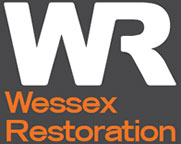
‘Ecce Homo’: before, and after restoration
With the rise of DIY and heritage restoration programmes on television, many homeowners are becoming increasingly tempted to take the restoration work of their heritage, conservation area and listed properties into their own hands: with disastrous results.
There’s nothing wrong with carrying out your own restoration work if you know what you’re doing. But the unfortunate rise in botched DIY restorations highlights how valuable it is to get an accredited professional to carry out a restoration.
‘Behold the Monkey’
One of the most famous incidents of modern times occurred in 2012, in Borja in North Eastern Spain. A local woman attempted the restoration of a fresco that would become soon become an internet sensation: and not for the right reasons.
‘Ecce Homo’ (translated as ‘Behold the man’) was a depiction of Jesus painted by the Spanish artist Elías García Martínez in the 1930s. Due to years of deterioration caused by humidity, the fresco was in a bad condition. An octogenarian, who was involved with the church and who was also an amateur artist, decided to restore it herself.
Despite being carried out with the best of intentions at heart, the resulting restoration attempt quickly achieved notoriety across the internet and in the worldwide media for its unsympathetic likeness to Christ. Many people even christened the restored fresco, ‘Ecce Mono’ (‘mono’ being Spanish for ‘monkey’– ‘Behold the monkey’) for its resemblance to a primate.
Inferior quality
The finished standard of an amateur’s work can never be estimated accurately: with no official qualification or sustained experience, how can you be sure that their work meets a consistent standard? By using a professional, qualified craftsman with several years of experience behind them to restore a heritage feature, you can be sure that the finished result will meet an excellent standard of quality.
Unsympathetic restorations
Not only will the risks of inferior quality renovation taking place rise if you use an amateur to carry out work, you’ll also run the risk of your property receiving an unsympathetic restoration.
Maintaining continuity in the aesthetic of a property is perhaps one of the most important things to consider when renovating a property.
For example, if your property is in a conservation area noted for its Georgian sash windows, you wouldn’t replace these with yellow powder coated uPVC tilt and turn windows because the technology, design and aesthetic would obviously not fit with the period that your property is supposed to be representative of.
Why is it important to get it right?
Obviously, getting your heritage renovation right the first time will save you money and be a good investment for the future. This aside though, there is also the very real threat of legal action for some properties if a restoration is not carried out to a specific standard.
If your home is listed, or in a conservation area, there will be certain aesthetic considerations that you must take into account when carrying out a heritage restoration. This could be anything from ensuring that you use a particular building material, such as a special type of stone or wood, to making sure that the finished restoration uses a particular period technology, or is in a particular period style.
For example, if you were looking to restore a stone gargoyle on a listed church in the Georgian city of Bath, legal requirements would mean that the gargoyle would have to be made of local Bath stone, in order to fit in with the traditional aesthetic of the city.
Both the builder and the customer are held legally responsible for the result of any work carried out in a property. The maximum penalty for carrying out any unauthorised work on a listed building, or on a building in a conservation area, can be 2 years in prison and an unlimited fine. It really is important to get heritage restoration right the first time.
Restoration and renovation specialists in Bristol, Cardiff and the South West.
Wessex Restoration are specialists in the restoration and renovation of heritage properties through Bristol, Cardiff and the South-West region. With an exceptionally skilled team of traditional craftsmen, we place great emphasis on the quality of our products and services.
We’ve worked on some illustrious properties in our history. For more information about any of our products or services, get in touch with the Wessex Restoration team today.




